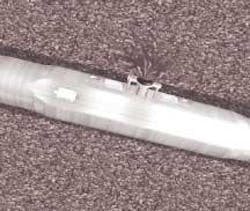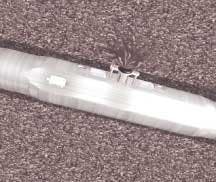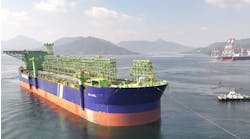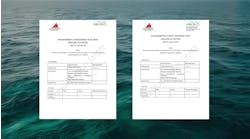Frank Hartley • Houston
Hughes Christensen engineers have incorporated a new generation of cutters and patented depth-of-cut control technology to increase bit stability and durability in demanding applications such as hard and abrasive formations, the company says.
Engineers optimized the interface between the tungsten carbide substrate and the synthetic diamond table to improve cutter toughness of the Odyssey Series cutters. In addition, the latest innovations in layered diamond table technology have been applied to provide greater abrasion resistance.
According to Hughes Christensen, the depth-of-cut control technology has been adapted to the SmoothCut design for general-purpose applications to provide smoother, more stable drilling, especially through inter-bedded formations. This improves bit longevity and overall drilling efficiency.
A new slimhole line of metal sealed tungsten carbide insert (TCI) and steel tooth Tricone bits, optimized for drilling long directional or horizontal wells, has been introduced. The new "Mini-MX" bits are specifically designed for demanding, high-speed applications. It is a premium small diameter bit with all the features of its larger predecessor. Technologies to protect the bearing seal have been integrated into a smaller metal sealed bearing package with tighter tolerances and greater reliability than an elastomer sealed bit. These bits use a single energizer metal seal (SEM) system to provide an alternative to elastomer sealed bearings for high-speed directional drilling, which often requires high total bit revolutions to achieve directional objectives and finish the hole section. The SEM system relies on a metal face seal where all relative rotary motion occurs between two highly polished and lubricated metal surfaces. This type of low friction metal face seal thrives at higher rotary speeds (200 to 300+ rpm), whereas radial elastomer seal performance tends to degrade at these rotary speeds resulting in accelerated elastomer seal wear and reduced bearing life expectancy.
Mud packing is a common occurrence in bits used on motors and in directional applications, particularly when drilling shales and claystones. To address this issue, the bit uses technology targeted specifically at preventing the detrimental effects of mud packing. A mud wiper TCI button works in tandem with a groove in the cone backface to wipe away cuttings that tend to adhere to the cone. Finally, to keep the metal seal bearing well lubricated, the bit uses the "Equalizer" lubrication system – an advanced pressure compensation system that features a spring loaded cap to reduce vibration and fretting and a pinhole relief system to limit internal pressure build-up.
A clean sweep nozzle configuration cleans areas of the cutting structure prone to bit- balling and provides return flow through deep junk slots. The hydraulics system ensures high penetration rates throughout the run, the company said.
Faster decision application
A new application platform provides enhancements for aiding in the rapid configuration of new analytic applications and new deployment support for Sun Java, System Portal Server, Java System Directory Server and IBM Websphere. The Deci-sionSite MapConnect (www.spotfire.com) links ESRI map data with E&P project data so analysts can uncover hidden relationships, trends, and patterns and make faster, higher quality decisions. The system can be rapidly configured to support many applications that help exploration teams make better, faster decisions about how to allocate capital investments among prospective wells and oilfield assets. Example applications include prospect assessment and validation, environmental impact analysis, pipeline security and safety management, and many others.
Additionally, the DecisionSite Posters tool has been enhanced to give analysis teams a way to distribute analysis results and data to specific functional experts, partners, and managers. For IT organizations building and deploying portal-based applications, the tool was enhanced to support the Sun Java System Portal Server.
New formation tester
An evaluation of LWD formation pressure testing technology by Statoil and Baker Hughes Inteq has concluded that the new tester, the TesTrak system, measures formation pressure through direct contact with the formation and transmits the pressure data to surface in real-time. An intelligent, closed loop, drawdown control system makes it possible to complete a test in 5 min or less, the companies said.
null
Statoil compared the results from this system with traditional wireline formation tester in multiple Norwegian shelf wells. The measurements compared well, although small differences were noted in low-permeability reservoirs. Based on their observations, Statoil qualified the service as a replacement for the wireline pressure testing service and will continue to evaluate the tool's performance in low-permeability reservoirs. This is the first LWD formation pressure-tester to be officially qualified by Statoil.
The combination of rotary steering technology and this service will enable Statoil and other operators to extend their reach to distant reservoirs, test them, and reduce their operating costs by eliminating additional pipe trips for wireline tester runs.
Hostile environment logging
Precision Drilling Corp. says it has operated a MWD/LWD tool at 375° F and 347° F bottomhole temperatures, respectively, providing wellbore and formation data in record high-temperature wellbore conditions.
One of the company's systems provided wellbore directional data, as well as gamma ray and bore/annular pressure, at circulating bottomhole temperatures up to 375° F during 12 days of drilling on the Carrillo Conoco Fee No. 1 well. A surface gyro was run and confirmed directional survey accuracy within 1°.
On the Peach Creek Gas Unit No. 5 well, adverse hole conditions prevented wireline logging due to the risk of tools getting stuck. The LWD system recorded gamma ray, multi-frequency resistivity, azimuthal density, and thermal neutron porosity in 17.8-lb/gal oil-based mud at 347° F circulating bottomhole temperature to 16,250 ft. The LWD logs were reported to be wireline-quality.




